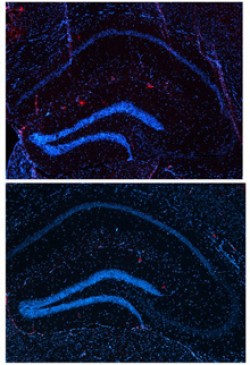Drug Improves Alzheimer’s-like Condition in Mice
Drug Improves Alzheimer’s-like Condition in Mice
Scientists report that a decade-old cancer drug quickly clears proteins linked to Alzheimer’s disease from the brains of mice. The drug restores memory, social behavior and other defects often seen with the disorder. But more study will be needed to see if the medication is safe and effective for patients with Alzheimer’s disease.
 After 2 weeks, the brains of mice treated with bexarotene (bottom) have fewer amyloid plaques (red) than untreated mice (top). Image by Cramer et al., courtesy of Science.
After 2 weeks, the brains of mice treated with bexarotene (bottom) have fewer amyloid plaques (red) than untreated mice (top). Image by Cramer et al., courtesy of Science.
Alzheimer’s disease is a progressive brain disorder that slowly destroys memory and thinking skills. Those affected eventually lose the ability to recognize their loved ones or perform normal daily tasks of living. Symptoms usually begin to appear after age 60.
In the most common, late-onset form of the disorder, the brain contains abnormally high levels of a sticky protein fragment called beta-amyloid. These fragments can clump together and create amyloid deposits, or plaques. In healthy people, a protein called apolipoprotein E (ApoE) helps to clear excess beta-amyloid out of the brain. Some people with Alzheimer’s disease may not produce enough normal ApoE, so beta-amyloid levels may rise.
To correct the beta-amyloid overload, Dr. Gary Landreth of Case Western Reserve University and his colleagues searched for a drug that might boost ApoE production. They identified a medication called bexarotene, approved by the U.S. Food and Drug Administration for treating skin cancer. The drug is relatively safe, and it activates a molecular switch that turns on ApoE production. The research was supported in part by NIH’s National Institute on Aging (NIA) and National Institute on Deafness and Other Communication Disorders (NIDCD).
The scientists gave bexarotene to transgenic mice that develop amyloid plaques early in life and show Alzheimer’s-like brain abnormalities and behaviors. The results appeared in the February 9, 2012, advance online edition of Science.
The researchers found that bexarotene rapidly reduced beta-amyloid levels in the brains of mice of all ages and shrank plaques in most age groups. In the youngest mice, beta-amyloid levels fell sharply just 6 hours after treatment. In 6-month-old mice, daily doses of bexarotene led to a sustained 30% drop in soluble beta-amyloid throughout the 14-day treatment period. Plaques were reduced by about 75%.
The drug also seemed to reverse abnormal behaviors. It rapidly restored cognition and memory in mice, as measured by a test of learned fears. Treated mice performed better in water maze tests, and their nesting behaviors—an indication of social behavior—were restored. The drug also improved the animals’ ability to sense and respond to odors. Loss of smell is often a first symptom of Alzheimer’s disease in humans.
Although preliminary, the results suggest that treatments aimed at boosting ApoE activity might be an effective approach for blocking the progression of Alzheimer’s disease.
“This is a particularly exciting and rewarding study because of the new science we have discovered and the potential promise of a therapy for Alzheimer’s disease,” says Landreth. “The drug works quite well in mouse models of the disease. Our next objective is to ascertain if it acts similarly in humans. We are at an early stage in translating this basic science discovery into a treatment.”
By Vicki Contie
###
* The above story is reprinted from materials provided by National Institutes of Health (NIH)
** The National Institutes of Health (NIH) , a part of the U.S. Department of Health and Human Services, is the nation’s medical research agency—making important discoveries that improve health and save lives. The National Institutes of Health is made up of 27 different components called Institutes and Centers. Each has its own specific research agenda. All but three of these components receive their funding directly from Congress, and administrate their own budgets.




















